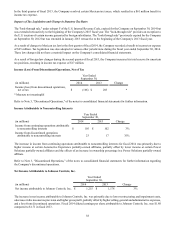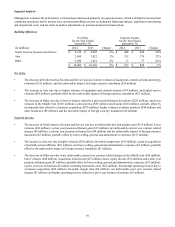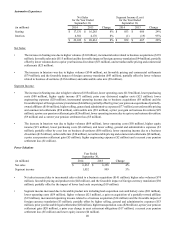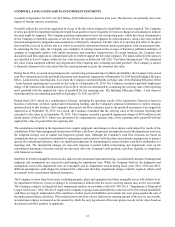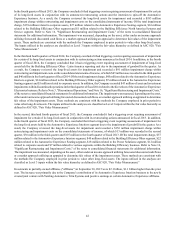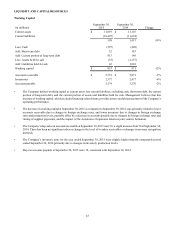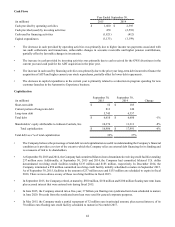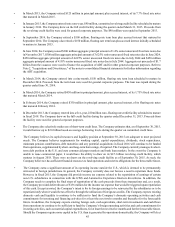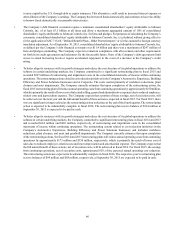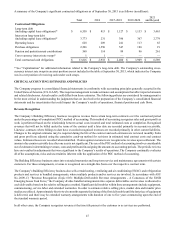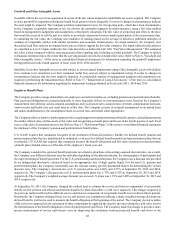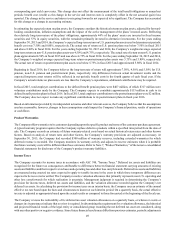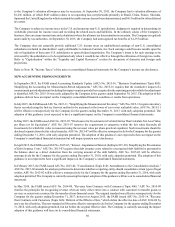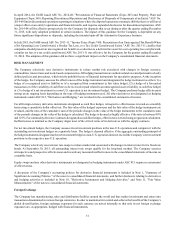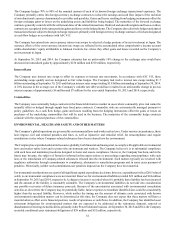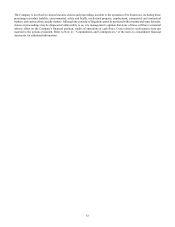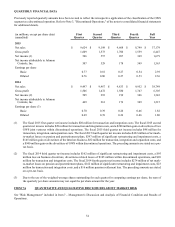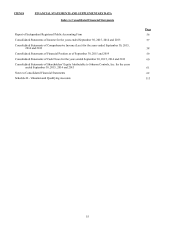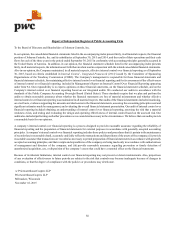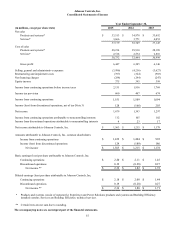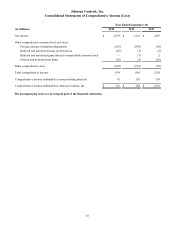Johnson Controls 2015 Annual Report Download - page 48
Download and view the complete annual report
Please find page 48 of the 2015 Johnson Controls annual report below. You can navigate through the pages in the report by either clicking on the pages listed below, or by using the keyword search tool below to find specific information within the annual report.48
Goodwill and Other Intangible Assets
Goodwill reflects the cost of an acquisition in excess of the fair values assigned to identifiable net assets acquired. The Company
reviews goodwill for impairment during the fourth fiscal quarter or more frequently if events or changes in circumstances indicate
the asset might be impaired. The Company performs impairment reviews for its reporting units, which have been determined to
be the Company’s reportable segments or one level below the reportable segments in certain instances, using a fair value method
based on management’s judgments and assumptions or third party valuations. The fair value of a reporting unit refers to the price
that would be received to sell the unit as a whole in an orderly transaction between market participants at the measurement date.
In estimating the fair value, the Company uses multiples of earnings based on the average of historical, published multiples of
earnings of comparable entities with similar operations and economic characteristics. In certain instances, the Company uses
discounted cash flow analyses or estimated sales price to further support the fair value estimates. The inputs utilized in the analyses
are classified as Level 3 inputs within the fair value hierarchy as defined in ASC 820, "Fair Value Measurement." The estimated
fair value is then compared with the carrying amount of the reporting unit, including recorded goodwill. The Company is subject
to financial statement risk to the extent that the carrying amount exceeds the estimated fair value. Refer to Note 6, "Goodwill and
Other Intangible Assets," of the notes to consolidated financial statements for information regarding the goodwill impairment
testing performed in the fourth quarters of fiscal years 2015, 2014 and 2013.
Indefinite lived other intangible assets are also subject to at least annual impairment testing. Other intangible assets with definite
lives continue to be amortized over their estimated useful lives and are subject to impairment testing if events or changes in
circumstances indicate that the asset might be impaired. A considerable amount of management judgment and assumptions are
required in performing the impairment tests. Refer to Note 17, "Impairment of Long-Lived Assets," of the notes to consolidated
financial statements for information regarding the impairment testing performed in fiscal years 2015, 2014 and 2013.
Employee Benefit Plans
The Company provides a range of benefits to its employees and retired employees, including pensions and postretirement benefits.
Plan assets and obligations are measured annually, or more frequently if there is a remeasurement event, based on the Company’s
measurement date utilizing various actuarial assumptions such as discount rates, assumed rates of return, compensation increases,
turnover rates and health care cost trend rates as of that date. The Company reviews its actuarial assumptions on an annual basis
and makes modifications to the assumptions based on current rates and trends when appropriate.
The Company utilizes a mark-to-market approach for recognizing pension and postretirement benefit expenses, including measuring
the market related value of plan assets at fair value and recognizing actuarial gains and losses in the fourth quarter of each fiscal
year or at the date of a remeasurement event. Refer to Note 15, "Retirement Plans," of the notes to consolidated financial statements
for disclosure of the Company's pension and postretirement benefit plans.
U.S. GAAP requires that companies recognize in the statement of financial position a liability for defined benefit pension and
postretirement plans that are underfunded or unfunded, or an asset for defined benefit pension and postretirement plans that are
overfunded. U.S. GAAP also requires that companies measure the benefit obligations and fair value of plan assets that determine
a benefit plan’s funded status as of the date of the employer’s fiscal year end.
The Company considers the expected benefit payments on a plan-by-plan basis when setting assumed discount rates. As a result,
the Company uses different discount rates for each plan depending on the plan jurisdiction, the demographics of participants and
the expected timing of benefit payments. For the U.S. pension and postretirement plans, the Company uses a discount rate provided
by an independent third party calculated based on an appropriate mix of high quality bonds. For the non-U.S. pension and
postretirement plans, the Company consistently uses the relevant country specific benchmark indices for determining the various
discount rates. The Company’s discount rate on U.S. pension plans was 4.40% and 4.35% at September 30, 2015 and 2014,
respectively. The Company’s discount rate on U.S. postretirement plans was 3.75% and 4.35% at September 30, 2015 and 2014,
respectively. The Company’s weighted average discount rate on non-U.S. plans was 3.15% and 3.00% at September 30, 2015 and
2014, respectively.
At September 30, 2015, the Company changed the method used to estimate the service and interest components of net periodic
benefit cost for pension and other postretirement benefits for plans that utilize a yield curve approach. This change compared to
the previous method will result in different service and interest components of net periodic benefit cost (credit) in future periods.
Historically, the Company estimated these service and interest cost components utilizing a single weighted-average discount rate
derived from the yield curve used to measure the benefit obligation at the beginning of the period. The Company elected to utilize
a full yield curve approach in the estimation of these components by applying the specific spot rates along the yield curve used in
the determination of the benefit obligation to the relevant projected cash flows. The Company made this change to provide a more
precise measurement of service and interest costs by improving the correlation between projected benefit cash flows to the


